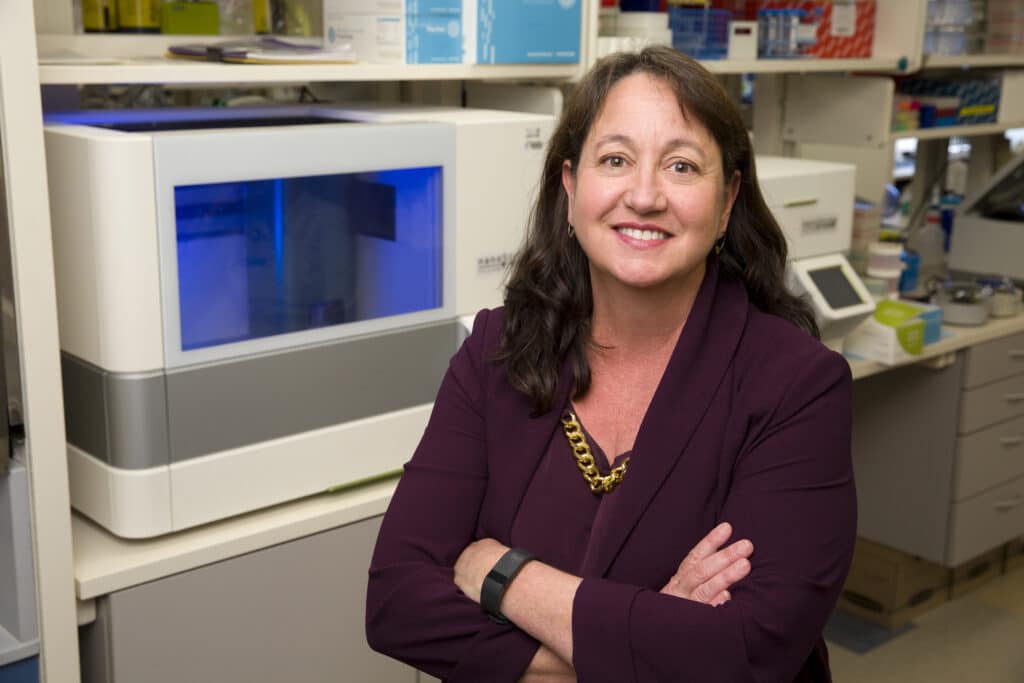Patient Perspectives: Understanding Diagnostic Testing

Doctors need the results of different diagnostic tests to accurately determine whether or not a patient has lymphoma. These tests can also determine a patient’s specific lymphoma subtype. After the initial diagnosis of lymphoma, a doctor may order other tests such as blood tests, molecular genetics or biomarker tests, to gain a more accurate diagnosis and develop the most appropriate treatment plan based on the results.
Lymphoma specialist Lisa Rimsza, MD (Mayo Clinic, Arizona) describes these tests in-depth and how they can help patients understand their lymphoma subtype and become their own best health advocate.
How are lymphomas and CLL generally diagnosed?
The diagnosis comes through a biopsy of tissue, bone marrow, or sometimes blood, which undergoes microscopy and some combination of immunophenotyping (looking at the proteins on the abnormal cells), cytogenetics (looking at the chromosomes), FISH (looking at specific parts of chromosomes or genes), and molecular studies (looking at particular gene sequences and other features). This information is correlated by the pathologist with the patient’s clinical history, blood findings (counts, protein electrophoresis or immunofixation, and others), and radiological findings.
What types of biopsies are acceptable for an accurate diagnosis?
For a new diagnosis, the more tissue, the better the chance to identify all of the needed diagnostic features. With advanced techniques and a specific type of lymphoma, a small biopsy such as a needle core biopsy might be conclusive. However, usually, there is a better chance of getting a specific diagnosis from an initial procedure if a larger, excisional biopsy is obtained. Think of it as trying to figure out what type of car you have from just a photo of a tire and a seat (pieces of tissues from aspirates and needle cores) or having a photo of the entire car (excisional biopsy).
We hear the term “next-generation sequencing” quite a bit nowadays. Can you please explain what this refers to and how it might be useful for blood cancers?
First-generation sequencing refers to Sanger sequencing (developed by Dr. Frederick Sanger in the 1970s). It used electrophoresis and was laborious (although technology improved over the years); however, Sanger is extremely accurate and still used in certain situations. Since the mid-2000s, multiple other methods have been developed, all of which are considered “next-generation”, these are quick, generate a lot of data, and are automated.
What are biomarkers? What are some common biomarkers that exist on either B-cell or T-cell lymphomas?
Biomarkers are any type of test that helps to classify disease, estimate a patient’s prognosis, or provide information on potential effective treatments. For B cell lymphomas common biomarkers are related to lymphoma classification and prognosis such as the presence of chromosomal rearrangements involving the MYC, BCL2, BCL6, or CCND1 genes; while some gene mutations may suggest therapeutic approaches such as MYD88 or EZH2. Serum markers such as “M-protein” or LDH enzyme are also biomarkers. In T-cell lymphoma, classification and prognosis might be related to ALK or DUSP22 gene rearrangements.
If patients experience a relapse, are diagnostic tests necessary at this point as well?
Yes, it is important to determine if the lymphoma is showing similar features to the original. Particularly if the first tumor was considered “low-grade” then progression to a “high-grade” tumor would be very important to know. This is also a time point at which additional testing might be performed to evaluate the tumor for alternative therapies. It is also always possible that it is an entirely different tumor or process.
Are there any diagnostic tests that patients should request?
Testing algorithms are established by the Pathologists and laboratory based on medical practice and the context provided by the patient’s treating Hematologist. The panel of tests that the tissue will undergo is part of the triage process that happens when the material is received in the laboratory so that certain protocols are followed. The guidelines are highly complex and evolving. The specific features of the patient’s tumor such as size, presence of dead tissue, dilution with blood, or other factors will also be considered. Often, the Hematologist will ask for a very specific test based on their knowledge of the situation. After the testing is complete and the diagnosis is established, the patient may wish to discuss the testing rationale and if there is anything else that needs to be done with their doctor.
In your opinion, why is it important for patients to know their specific type of lymphoma?
There are now more than 100+ different types of lymphomas. Each lymphoma has a different biology and clinical course, and therefore different treatment and monitoring strategies. What is true for one type of lymphoma may be completely incorrect with regard to another type. The basis of a patient understanding their disease is knowing their specific lymphoma diagnosis.
If a patient doesn’t know their specific subtype, what should they do to seek/understand that information?
If a patient doesn’t know what type of lymphoma they have, they should first start with their hematologist or other treating physician to clarify the working diagnosis. The patient can also request to see the pathologist’s report on their tissue describing the testing that was done and the conclusions. In an emerging trend, some patients have requested to directly meet with the pathologist who made the diagnosis. Armed with the information about a specific subtype, the patient can then approach groups such as the Lymphoma Research Foundation or the American Society of Clinical Oncology, which have great patient resources.

